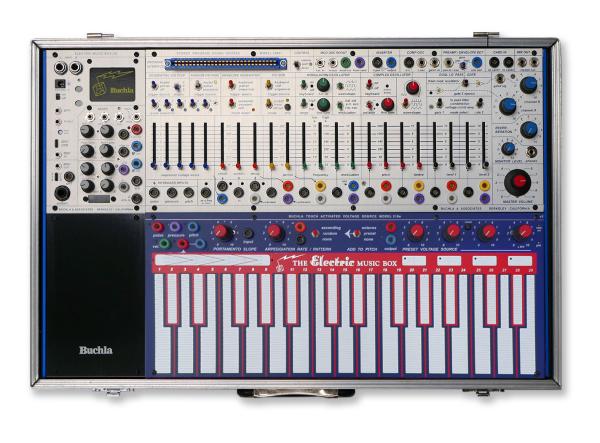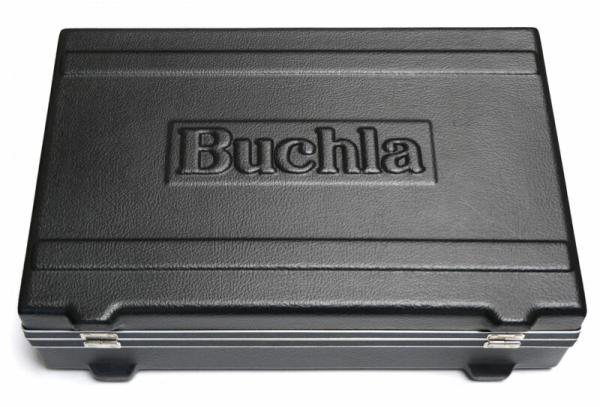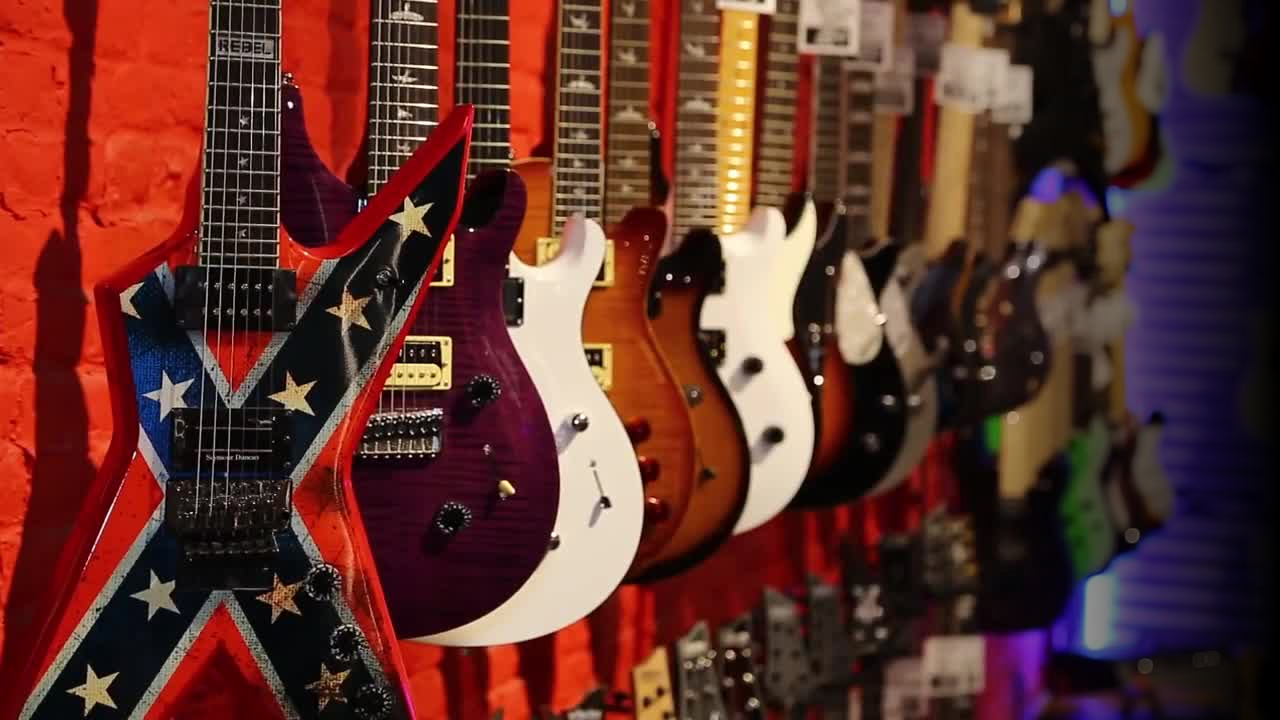Buchla Music Easel (Modern)
This modern version of the Music Easel combines the 208C and the 218e V3 in a flat and portable housing with pleasant Sifam poti knobs. All inputs and outputs are contained in a single module. There is even room for an additional module. The Electric Music Box I/O module includes MIDI, USB-C, ground, mixer, slewing, LFO, and crossfader. The USB port of the 208C is used to connect to the program manager, and with the 218e V3, it is possible to install new firmware. The Music Easel is a very well-designed semi-modular instrument, with excellent sound and many possibilities thanks to well-arranged patch points.
The small sequencer and the touch keyboard with built-in arpeggiator invite you to play the instrument directly and interact with it, which is very fun and allows you to create interesting polyrhythmic patterns. When synchronized with MIDI, the arpeggiator speed control acts as a clock division control and allows you to create triplets and other divisions.
At first glance, the Easel may seem daunting because of the many switches, faders, and jacks, without labeling, but ultimately, everything makes sense and is arranged very logically. The colors of the jacks correspond to the functional blocks of the Easel (purple = keyboard pressure, yellow = pulser, white = random, orange = envelope, blue = sequencer). The black jacks are CV inputs that are always located to the left of the corresponding parameter. The jacks on the top of the unit are labeled and self-explanatory. The positioning of most banana jacks under the faders has been chosen for the use of shorting bars instead of patch cords, which improves the clarity of your patch.
The sound generation of the Easel is based on a complex primary oscillator and a modulation oscillator. The latter is usually used to modulate the main VCO, but it can act as a second VCO and can be routed to the 2nd Low Pass Gate, see below.
The primary oscillator can be tuned over 5 octaves with the frequency fader, and the response to incoming CV can be modified with the +/- polarity switch. The waveform depends on the controls of two sections: With the timbre fader and the waveform potentiometer set to zero, we get a sine wave. By increasing the waveform potentiometer, the waveform changes from sine to triangle, square, or needle pulse, depending on the switch. The timbre fader modifies this waveform using a wave multiplier for sounds with high harmonic content.
The modulation oscillator has no timbre section, only switchable waveforms (saw, square, or triangle). In HI mode, it is a VCO, in LOW mode, it is an LFO. Its frequency can be modulated by the keyboard (switchable) or by a CV. A switch determines how the modulation oscillator affects the primary oscillator, either as a ring modulator, amplitude modulation, or frequency modulation. The modulation intensity is set using the modulation fader, but can also be controlled by voltage.
The oscillator(s) is (are) processed by the Low Pass Gates (LPG). These are vactrol-based circuits with organic behavior that can function as low-pass filters, as VCAs (gate), or as a combination of both. The audio signal for the first LPG is always the main VCO. The second LPG is phased by 180° and has flexible routing: either the output of LPG1 (which creates high-pass sounds due to the phased phase), the modulation oscillator, or an external audio signal. The outputs of the LPGs are mixed in the output section, and their levels can be adjusted separately. Behind the mixer is a real spring reverb with a dry/wet setting that adds depth to the Easel's sound when needed.
The Easel can be played with the touch keyboard and/or the sequencer. The keyboard detects the amount of skin touching it, which gives pseudo-pressure sensitivity. Its range is 2.5 octaves, but you can transpose octaves using the four pads located at the top right. During normal play, it detects one finger determining pitch, but when using the internal arpeggiator, all fingers are analyzed. The arpeggiator has its own tempo control and can be synchronized with MIDI.
The Pulser is a pulse generator that you can use as a clock source or as a second LFO. It can repeat itself or be triggered by the key gate or the sequencer. The envelope is AD or ASR type, depending on the setting, and can be triggered by the pulser, the sequencer, or the keyboard gate. The analog sequencer has three, four, or five steps and has step gate switches; its gate source can be the pulser or the keyboard gate. The interaction between switch settings and simultaneous play on the keyboard can lead to very interesting polyrhythmic structures.
The four touch pads mentioned above can not only transpose octaves; in "preset" setting, four predefined fixed voltages can be played to change pitch or other parameters.
Synthesizer System:
- Components:
- Stored Program Sound Source Model 208C
- Touch Activated Voltage Source Model 218e (v3)
- Electric Music Box Input/Output (EMBIO)
Stored Program Sound Source Model 208C:
- Includes:
- Complex Oscillator
- Modulation Oscillator
- Noise Generator
- Features:
- Five-Stage Sequencer
- Envelope Generator
- Pulser
- Modulation Source
- Dynamic Control:
- Dual Low Pass Gate
- Tone and Amplitude Control
- Modulation:
- Various Modulation Sources
- Extensive Patch Field
- Sonic Exploration:
- Mixer Section with Spring Reverb
Touch Activated Voltage Source Model 218e (v3):
- Layout:
- Piano-Like Keyboard
- Features:
- Adjustable Sensors
- Pressure Sensitivity
- MIDI Output
Electric Music Box Input/Output (EMBIO):
- Connectivity:
- MIDI
- CV
- Audio Output
- Features:
- Audio Mixer
- CV Conditioners and Controls
Euroguitar Referenz : 110966















